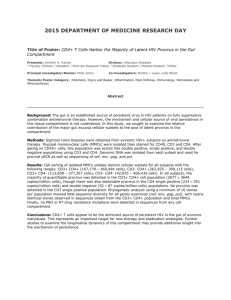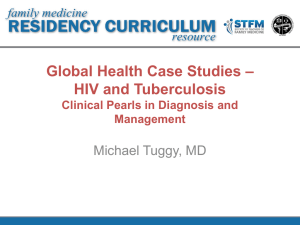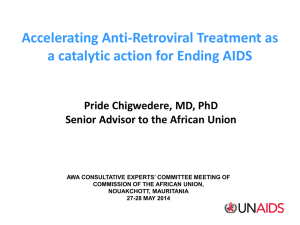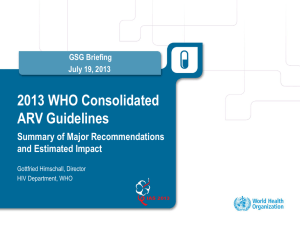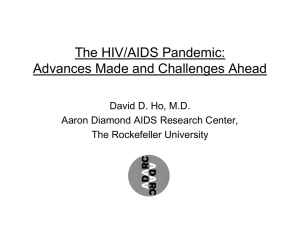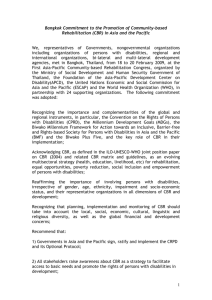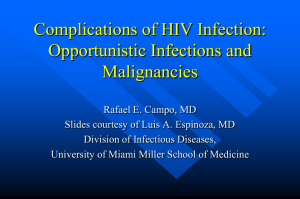View slides
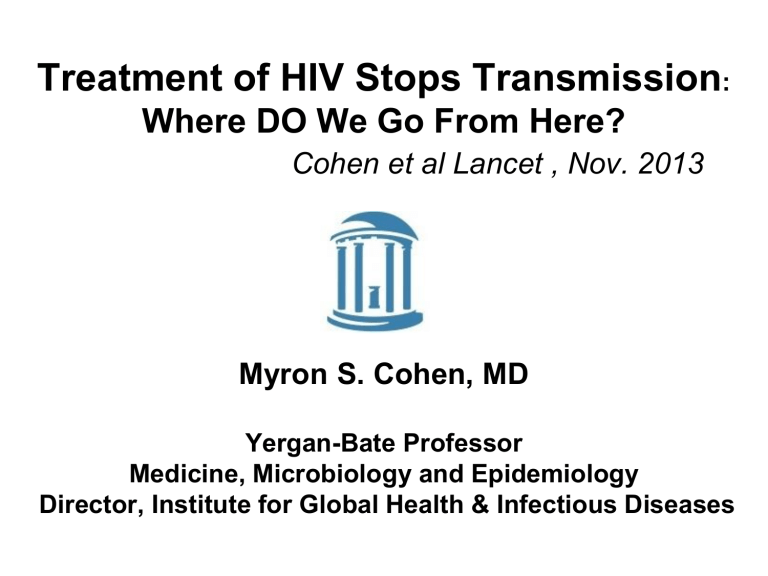
Treatment of HIV Stops Transmission
:
Where DO We Go From Here?
Cohen et al Lancet , Nov. 2013
Myron S. Cohen, MD
Yergan-Bate Professor
Medicine, Microbiology and Epidemiology
Director, Institute for Global Health & Infectious Diseases
BACK TO BASICS
How HIV Became Pandemic
Ro = bDC
When Ro >1 epidemic is sustained b = Efficiency of transmission
D = Duration of infectiousness
C = Number of people (partners) exposed
Anderson and May, 1966
Viral Load Predicts Heterosexual Transmission
Source: Quinn et al. (2000). N Engl J Med, 342, 13, 921–929.
Four Prevention Opportunities
Cohen et al. Lancet, 2013
UNEXPOSED EXPOSED
(precoital/coital)
EXPOSED
(postcoital)
INFECTED
Behavioral,
Structural
Structural
Circumcision
Condoms
Vaccines
ART PrEP
Microbicides
Vaccines
ART PEP
Treatment Of HIV
Reduced Infectivity
YEARS HOURS 72h YEARS
AIDS 24:621, 2010
Four Prevention Opportunities
Cohen et al. Lancet, 2013
UNEXPOSED EXPOSED
(precoital/coital)
EXPOSED
(postcoital)
INFECTED
Behavioral,
Structural
Structural
Circumcision
Condoms
Vaccines
ART PrEP
Microbicides
Vaccines
ART PEP
Treatment Of HIV
Reduced Infectivity
YEARS HOURS 72h YEARS
Antiretroviral Exposure at Mucosal Surfaces
Rectal Tissue, CVF, Semen Exposure Relative to Blood
1000
CCR5
Receptor
Antagonists
Integrase
Inhibitors
Nonnucleoside
RT Inhibitors
Nucleoside(tide)
RT Inhibitors
Protease
Inhibitors
100
10
1
0.1
0.01
RAL (150)
TFV (46)
MRV (27)
MRV (4)
MRV (0.6)
RAL (2)
RAL (1)
CCR5 RA
RECTAL TISSUE
INSTI
ETR (8)
ETR (1.3)
NVP (0.8)
NVP (0.7)
EVF (0.6)
DLV (0.2)
ETR (0.15)
EFV (0.03)
RTV (13)
FTC/
3TC (4)
3TC (6)
TFV (5)
ZDV (2)
D4T (3.5)
FTC (2.6)
ZDV (2)
TFV (1) ABC (1.5)
DDI (0.21)
IDV (2)
DRV (2.7)
IDV (1)
APV (0.5)
RTV (0.3)
ATV (0.18)
APV (0.2)
DRV (0.17)
ABC (0.08)
D4T (0.05)
LPV (0.08)
LPV/NFV
(0.05)
SQV & RTV
(0.03)
SQV (ND)
NNRTI
CERVICOVAGINAL FLUID
ARV Class
NRTI
SEMEN
PI
HPTN 052 Enrollment
Cohen et al NEJM, July 2011
Americas
278
U.S.
India
Kenya
Brazil
Botswana
South Africa
Malawi
Zimbabwe
Africa
954
Thailand
Asia
531
“The results have galvanized efforts to end the world’s
AIDS epidemic in a way that would have been inconceivable even a year ago”
Bruce Alberts , editor of Science
The Economist, June 2011
Risk Comparison of Serodiscordant Couples
Anglemeyer et al. JAMA 2013
HPTN 052: Primary Endpoints
Grinsztejn et al Lancet ID (in press)
Number of subjects experiencing >1 event
Tuberculosis
Delayed Immediate
34 (4%) 17 (2%)
Serious bacterial infection 13 (1%) 20 (2%)
WHO Stage 4 event
Oesophageal candidiasis
Cervical carcinoma
Cryptococcosis
HIV-related encephalopathy
Herpes simplex, chronic
Kaposi’s sarcoma
CNS Lymphoma
Pneumocystis pneumonia
Septicemia
HIV Wasting
Bacterial pneumonia
19 (2%) 9 (1%)
0
2
1
1
1
0
1
8
1
2
2
1
0
2
0
0
1
0
2
1
2
0
HIV-1 RNA and CD4 Over Time (ITT)
Grinstejn et al. Lancet ID (in press)
Immediate
Delayed
COHERE Study 1998-2010
Relationship between current CD4 and AIDS-defining illness with a CD4 count
≥500 cells/μL: relationship with current viral load and antiretroviral treatment
All patients ARV naive First 6 mo cART VL < 400 VL > 400
A. Mocroft, et al., Oxford Journal, August 2013
EVERYONE Should Start ART
IAS-USA DHHS Guidelines
• HIV replication has negative consequences
• Earlier ART prolongs survival
• ART blocks HIV transmission
BUT… arguments for delay in ART include
• Anticipated detection of novel “harm” (?)
• Ongoing search for visible “benefit” (?)
• START and TEMPERANO studies (?)
• Distracting focus on logistical challenges
HPTN 052 Cost Effectiveness
Walensky et al. NEJM, 2013
HPTN 052 results for India, South Africa used
Treatment/Prevention benefits both considered i) In South Africa, over the short term, early ART is “cost-saving” ii) Over time ART in INDIA and South
Africa proves “very cost effective”
Higher employment at CD4≥500
Thurminathy, Health Affairs ,2012
•
Compared to CD4<200,
CD4≥500 associated with
– 5.8 more days/month
– 2.2 more hours/day (40% more than ref. mean of 5.5)
Those with CD4≥500 worked nearly 1 week/month more than those with CD4<200, and as much as HIVuninfected adults
Regression model coefficients
Outcome:
CD4<200
CD4 200-349
CD4 350-499
CD4 ≥500
Observations
(1)
Days worked in the past month
Reference
2.7
4.8
5.8**
107
(2)
Hours worked on usual day in past
Reference
1.8
0.9
2.2*
107
• Linear regression model with age, age-squared, and sex included as controls
• ** p<0.05, * p<0.10
• Reference group has CD4<200
Who SHOULD We Treat?
•
Couples (WHO Guidelines)
•
CD4 Count>500 (WHO)
•
Pregnant women (WHO)
WHO estimates 26,000,00 people
Fig. 1a: Time series of maps showing the evolution of the proportion of the HIV-infected adults (≥15 years of age) receiving ART across the demographic surveillance area (2005 to
2008, left to right, top row; 2009 to 2011, left to right, bottom row).
F Tanser et al. Science 2013;339:966-971
Antiretroviral Treatment Prevents HIV
•
Axiom: viral suppression stops HIV spread
•
Axiom: immediate ART improves health
• 30 years of “mixed messages” are a problem
•
A NEW message will improve adherence
•
Immediate, universal ART is the best strategy available for the HIV pandemic



